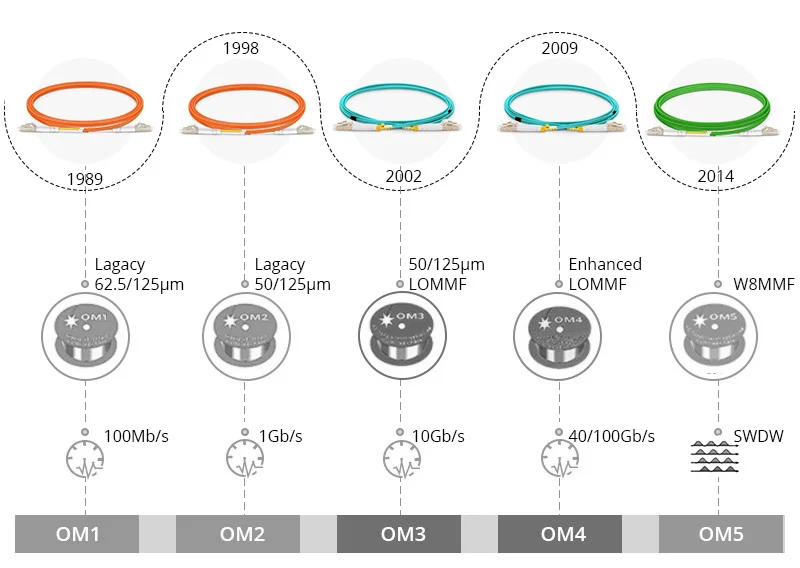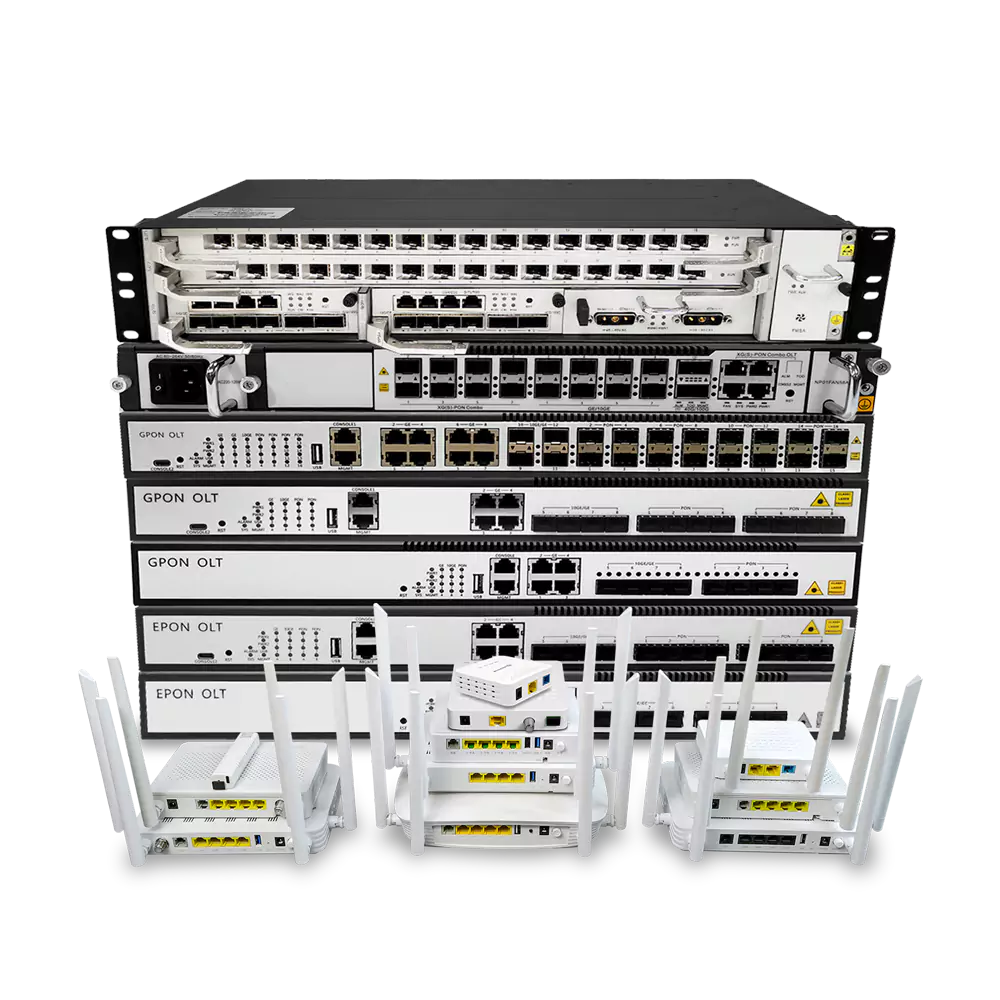OS2, OM1, OM2, OM3, OM4, and OM5 are standardized classifications of fiber optic cables. They represent single-mode fibers (OS) and multi-mode fibers (OM), differentiated by their core diameter, bandwidth, transmission distance, and application scenarios. Here’s a detailed explanation:
Single-Mode Fiber (OS)
1. OS2
- Definition: OS2 is a widely used single-mode fiber optimized for long-distance transmission.
- Wavelengths: Operates at 1310nm and 1550nm.
- Characteristics:
- Core diameter: 9μm.
- Low attenuation, especially at 1550nm (approx. 0.19 dB/km).
- Supports transmission over tens to hundreds of kilometers.
- Applications:
- Long-distance communication (e.g., metro networks, WANs, backbone networks).
- Data centers and telecom networks.
- Jacket Color: Typically yellow.
Multi-Mode Fiber (OM)
Multi-mode fibers are categorized into OM1, OM2, OM3, OM4, and OM5, with each supporting different levels of bandwidth and transmission distance.
2. OM1
- Definition: First-generation multi-mode fiber suitable for short-distance communication.
- Wavelengths: Operates at 850nm and 1300nm.
- Characteristics:
- Core diameter: 62.5μm.
- Bandwidth: Limited, supports up to 1Gbps over 300 meters at 850nm.
- Applications:
- Traditional LANs (Local Area Networks).
- Jacket Color: Orange.
3. OM2
- Definition: Second-generation multi-mode fiber with improved performance over OM1.
- Wavelengths: Operates at 850nm and 1300nm.
- Characteristics:
- Core diameter: 50μm.
- Supports 1Gbps transmission up to 550 meters at 850nm.
- Applications:
- LANs and upgraded short-distance communication.
- Jacket Color: Orange.
4. OM3
- Definition: High-performance multi-mode fiber designed for higher bandwidth applications.
- Wavelength: Optimized for 850nm.
- Characteristics:
- Core diameter: 50μm.
- Supports 10Gbps transmission up to 300 meters; supports 40Gbps and 100Gbps up to 100 meters.
- Compatible with VCSEL (Vertical-Cavity Surface-Emitting Laser) technology.
- Applications:
- Data centers, storage networks, and high-speed LANs.
- Jacket Color: Aqua (light blue).
5. OM4
- Definition: Enhanced version of OM3 with extended bandwidth and longer transmission distances.
- Wavelength: Optimized for 850nm.
- Characteristics:
- Core diameter: 50μm.
- Supports 10Gbps transmission up to 550 meters; supports 40Gbps and 100Gbps up to 150 meters.
- Applications:
- High-performance computing (HPC), large-scale data centers.
- Jacket Color: Violet or Aqua.
6. OM5
- Definition: New-generation multi-mode fiber designed to support Short Wavelength Division Multiplexing (SWDM).
- Wavelength: Operates across 850nm to 950nm.
- Characteristics:
- Core diameter: 50μm.
- Supports four wavelength channels in a single fiber for increased capacity.
- Supports 100Gbps transmission up to 150 meters.
- Applications:
- Large-scale data centers and future-ready network architectures.
- Jacket Color: Lime Green.

Comparison Summary
| Fiber Type | Core Diameter | Wavelength (nm) | Max Data Rate | Max Distance | Jacket Color | Applications |
|---|---|---|---|---|---|---|
| OS2 | 9μm | 1310/1550 | Tens of Gbps | Tens of kilometers | Yellow | Long-distance communication |
| OM1 | 62.5μm | 850/1300 | 1Gbps | 300 meters | Orange | Traditional LANs |
| OM2 | 50μm | 850/1300 | 1Gbps | 550 meters | Orange | Upgraded LANs |
| OM3 | 50μm | 850 | 10Gbps/100Gbps | 300 meters/100 meters | Aqua | High-speed networks, data centers |
| OM4 | 50μm | 850 | 10Gbps/100Gbps | 550 meters/150 meters | Violet or Aqua | High-performance computing |
| OM5 | 50μm | 850-950 | Multi-wavelength 100Gbps | 150 meters | Lime Green | Future-ready data centers |
How to Choose
- For long-distance transmission: Use OS2 single-mode fiber.
- For short-distance, high-speed transmission: Choose OM3, OM4, or OM5 multi-mode fibers, depending on specific bandwidth and distance requirements.
- For cost-effective solutions: Use OM1 or OM2 for standard LAN or short-distance needs.

